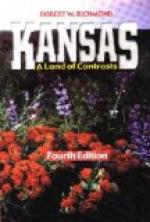[25] This suggestion of topsy-turvydom in the relations of God and Mammon is much intensified when we find an apartment house like the “Osborne” towering high above the church-spire on the opposite side of the way, or see Trinity Church simply smothered by the contiguous office buildings.
[26] Compare Montgomery Schuyler’s “American Architecture,” an excellent though brief account and appreciation of modern American building.
[27] The position of the Metropolitan Museum of Art is so assured that in 1896 its trustees declined a bequest of 90 paintings (claiming to include specimens of Velazquez, Titian, Rubens, and other great artists), because it was hampered with the condition that it had to be accepted and exhibited en bloc.
[28] This was changed to simple English in 1898.
[29] It is to this wind, the temperature of which varies little all the year round, that San Francisco owes her wonderfully equable climate, which is never either too hot or too cold for comfortable work or play. The mean annual temperature is about 57 deg. Fahr., or rather higher than that of New York; but while the difference between the mean of the months is 40 deg. at the latter city, it is about 10 deg. only at the Golden Gate. The mean of July is about 60 deg., that of January about 50 deg.. September is a shade warmer than July. Observations extending over 30 years show that the freezing point on the one hand and 80 deg. Fahr. on the other are reached on an average only about half a dozen times a year. The hottest day of the year is more likely to occur in September than any other month.
XII
Baedekeriana
This chapter deals with subjects related to the tourist and the guidebook, and with certain points of a more personal nature connected with the preparation of “Baedeker’s Handbook to the United States.” Readers uninterested in topics of so practical and commonplace a character will do well to skip it altogether.
When the scheme of publishing a “Baedeker” to the United States was originally entertained, the first thought was to invite an American to write the book for us. On more mature deliberation it was, however, decided that a member of our regular staff would, perhaps, do the work equally well, inasmuch as he would combine, with actual experience in the art of guidebook making, the stranger’s point of view, and thus the more acutely realise, by experiment in his own corpus vile, the points on which the ignorant European would require advice, warning, or assistance. So far as my own voice had aught to do with this decision, I have to confess that I severely grudged the interesting task to an outsider. The opportunity of making a somewhat extensive survey of the country that stood preeminently for the modern ideas of democracy and progress was a peculiarly grateful one; and I even contrived to infuse (for my own consumption) a spice of the ideal into the homely brew of the guidebook by reflecting that it would contribute (so far as it went) to that mutual knowledge, intimacy of which is perhaps all that is necessary to ensure true friendship between the two great Anglo-Saxon powers.




